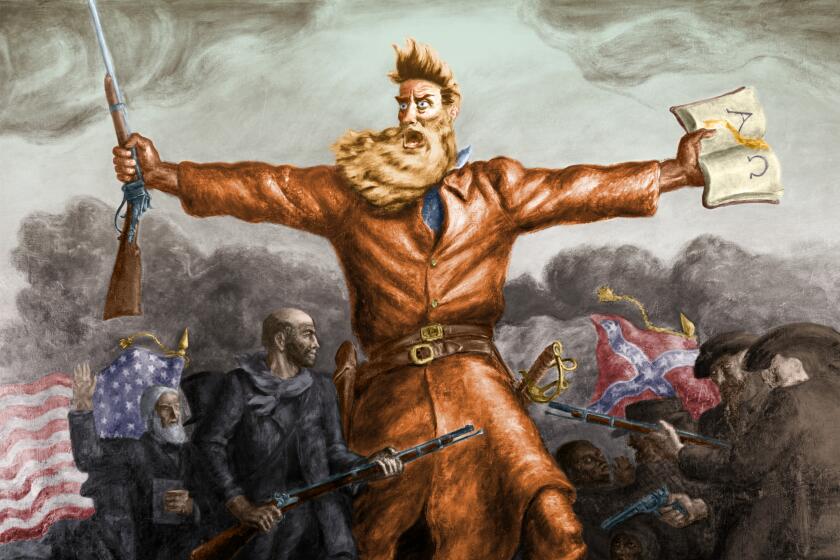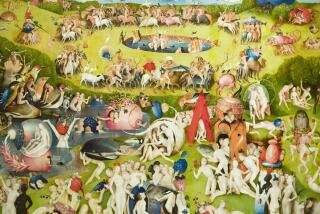Why would anyone want a paleo diet? We’re desperate for half-truths about human origins

- Share via
Can anyone offer a compelling, accurate story that explains the nature of humanity from its earliest origins? Scientist-intellectuals have tried to do so at least since the sci-fi author H. G. Wells struck gold in 1919 with “The Outline of History,” his influential attempt at telling “the whole story of man.” This effort endures as a trend. Jared Diamond, E.O. Wilson, Yuval Noah Harari, and David Graeber and David Wengrow are just some of the more recent authors to attempt grand accounts that veer from their professional training — and presume to explain human nature itself.
Offering as much entertainment as scientific truth, these books are often hits, met with breathless claims that they radically transform all we knew about humanity. Harari’s “Sapiens: A Brief History of Humankind” has sold some 25 million copies, counting Barack Obama and prominent Silicon Valley bros among his apostles. It argues that cognition and language produce beliefs that are shared across large groups to enable cooperation. The book imagines humanity as simply conceiving a picture and acting to make it true — like a developer designing and releasing an app — and it ignores individuals’ divergent problems, societies, thoughts and lives.
Population panic is a distraction.
More recently, Graeber and Wengrow sought in “The Dawn of Everything” to take down the myths of endless progress (exemplified in Steven Pinker’s unshakeable belief in it). Their book frames the anarchic lives of early human groups, who survived by moving among different kinds of social organization, as a celebration of biodiversity and flexibility against social hierarchies.
The question isn’t whether such tales are correct. Perhaps the clearest picture they produce is that our origins are complex enough that we can pick just about any guiding idea and find enough evidence to sustain it across the “human journey.” The real question is why we have such a gluttonous appetite for these stories. What makes us needy for half-truths in this genre?
Some of it has to do with the difficulty we face in understanding our world and answering basic questions about our existence: When was humanity born? What in particular made humans human? Were the early millennia a gruesome hellhole we were fortunate to escape, or a warm-hearted, halcyon era that we should strive to re-create? For a long time, our answers to these questions have used the past to guide our present and further contemporary agendas.
European and American archaeologists significantly shaped these efforts in the decade around Darwin’s “On the Origin of Species,” published in 1859. They got famous from the tools and skulls they dug out, and from the way they compared societies distant in space or time, concluding that humanity’s ancestors resembled today’s Indigenous peoples. By comparison, they thought themselves to be the pinnacle of human achievement. Then, after World War I, much of Europe went into a racial panic that colonial populations would rise up and overwhelm civilization. So they pushed a historical narrative that defined Indigenous peoples as “primitives” — vestiges of the oldest years of humanity.
Some fear that if children learn about slavery, they will lose respect for the founders. But they can appreciate those who fought for equality.
But the real obsession with prehistory began after World War II, when the collapse of Nazi Germany breathed life into three conflicting social goals that influenced public intellectuals. The first, in the wake of the Holocaust, was the desire to end racism. Organizations like UNESCO, relying on anthropologists, sociologists and geneticists, published histories explicitly aimed at emphasizing human unity and equality. Intellectuals across Europe, the U.S. and the Soviet bloc agreed: Science had to be wielded against the racism that had dominated recent decades and lived on. By 1970, prehistory was being taught around the world, in Poland, Kenya and Texas. Time-Life published lushly illustrated books telling a common human story, while the BBC and other channels beamed shows such as “The Ascent of Man” into living rooms.
The second goal was to explain violence. When Africa was recognized as the site of humanity’s origin, this came at a cost. Some scientists treated australopithecine ancestors — the evolutionary links between apes and humans — as savage creatures with an unslakable blood thirst. Robert Ardrey and other popular writers drew a straight line from that brutality to make the atom bomb almost inevitable. Humans were wired for destruction — violence supposedly hid inside everyone, just beneath a thin veneer of civilization. Neurologists and animal ethologists sought the bodily headwaters from which our natural aggression sprang forth.
Racism, supposedly banished, reared its head as the story circulated that humans’ innate propensity for violence survived in faraway peoples — far away from the West, that is. Explanations to justify existing social power structures multiplied: the “Man the Hunter” theory, for example, which proposed that early men led testosterone-filled hunts and war while the women (surprise!) did the gathering and hearth-keeping. Well-intentioned ethnographic films about “primitive warfare” made things worse. Audiences across the Global North could celebrate anew how far they had come from that life and view people of the Global South fighting for independence from colonialism as murderous, just like our human ancestors.
Books to read in March include “James” by Percival Everett, “Wandering Stars” by Tommy Orange and “Age of Revolutions” by Fareed Zakaria.
The third goal of the era’s fixation on prehistory was the most selfish. Every new science since the mid-century, including sociobiology and neuroscience, has claimed to answer the big questions about humanity’s meaning. No matter how controversial the research that supports them, such answers raise a field’s profile in the public sphere dramatically. And even after philosophers had discarded concepts like “human nature” as ill-defined and passé, the public had not.
Paleontologists usurped the place other intellectuals had left empty and became the go-to speakers for these ideas. The more religious conservatives fought against Darwin, the more TV stations gave airtime to scientists who offered answers for the fundamental questions of human existence. Audiences learned to link modern art to prehistory and inquire about Neanderthal DNA. The harder it was to come up with a strict definition of humanity, the more narratives about origins filled the void.
How much more do we know today about our ancient past? In terms of details, a lot more, such as the actual Neanderthal genome. But grand theories respond less to details than to other theories of the human experience that their proponents dislike.
Feminist archaeologists in the 1970s, for example, shaped their scientific findings to battle the sexist “Man the Hunter” story. By the 1990s, the notion that prehistoric life was harmonious was criticized as condescending. Diamond responded to these pressures in “The World Until Yesterday” by reveling in tales of Native brutality and discarding specific ethnographic explanations of that violence. Graeber and Wengrow, like political scientist James Scott, instead blamed early state formations (and modern European biases) for violence. Paleozoologists still wrestle with outdated conceptions of brutish Neanderthals. And so on: The deep past becomes a plaything for us to endlessly debate our own political ideas.
The steady stream of scientific discoveries reaching our screens makes us yearn ever more for a complete explanation. Yet the explanations we get will have little to do with the emergence of humanity itself. Meanwhile, we ignore the question we should be asking: Do we really share that much with cave-and-savannah-dwelling hominids from long ago? Or have we destroyed the Earth so irrevocably that we are desperate for our ancestors to tell us how to live?
Stefanos Geroulanos, the director of the Remarque Institute and a professor of history at New York University, is the author of the forthcoming “The Invention of Prehistory.”
More to Read
A cure for the common opinion
Get thought-provoking perspectives with our weekly newsletter.
You may occasionally receive promotional content from the Los Angeles Times.












